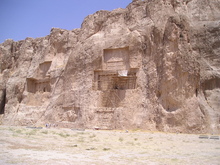| dc.coverage.spatial | Site: Naqsh-i Rustam (Iran) | en_US |
| dc.creator | Unknown | en_US |
| dc.date.accessioned | 2010-04-01T17:21:47Z | |
| dc.date.available | 2010-04-01T17:21:47Z | |
| dc.identifier | 139176 | en_US |
| dc.identifier.uri | http://hdl.handle.net/1721.3/49929 | en_US |
| dc.description | Rock-cut tomb. Relief carving above entrance depicts the standing king facing a fire altar with a winged deity above. Lengthy inscription behind king.
"Fire-holders like those at Pasargadae appear in carvings set over the rock-cut tombs of Darius the Great (reg 521–486 bc) and his successors at Naqsh-i Rustam and Persepolis (see fig. 1). There the king stands on a stepped plinth, right hand raised in salutation, before a fire-holder on a similar plinth, from which rises a pyramidal mass of flames. Above hovers a figure in a winged circle, dressed and bearded like the king, whom he faces, one hand raised in the same gesture, the other holding a ring (in Babylonian iconography a symbol of divinity). The winged circle derived ultimately from the winged disc of the Egyptian sun-god Horus, who was manifest in each pharaoh. This had been widely adopted in the Near East as a symbol of power and royalty, the human figure being added in Assyria. For the Achaemenids it probably symbolized both the royal khvarenah, the divine grace that attended kings, and the sun (to which, as a ‘glory’, the khvarenah was linked). In the funerary carvings a Mesopotamian moon symbol (a disc with crescent along its lower rim) is carved behind the figure in a winged circle, so that the king stands reverently before one earthly and two heavenly representatives of cosmic fire. The winged-circle symbol (with and without a human figure) appears also on palace walls and on seals...." [GDAO] | en_US |
| dc.description | general view, with Tomb of Artaxerxes I at left, 2003 | en_US |
| dc.format.medium | rock | en_US |
| dc.relation.ispartof | 124504 | en_US |
| dc.rights | (c) Melanie Michailidis 2003 | en_US |
| dc.subject | Rock-cut architecture | en_US |
| dc.subject | Royalty | en_US |
| dc.subject | Tombs | en_US |
| dc.subject | Darius I, King of Persia, 548-485 B.C. | en_US |
| dc.subject | Zoroastrianism | en_US |
| dc.subject | Achaemenid dynasty, 559-330 B.C. | en_US |
| dc.subject | Architecture --Iran | en_US |
| dc.subject | Sepulchral monuments | en_US |
| dc.subject | Scaffolds | en_US |
| dc.title | Tomb of Darius I | en_US |
| dc.type | Image | en_US |
| dc.rights.access | All rights reserved | en_US |
| dc.identifier.vendorcode | Achaemenid Tombs, Naqsh-i Rostam.jpg | en_US |
| vra.culturalContext | Persian | en_US |
| vra.culturalContext | Islamic | en_US |
| vra.technique | carving (processes) | en_US |
| vra.worktype | Tomb | en_US |
| dc.contributor.display | Persian, Islamic | en_US |


